
Mario Party is a party video game series featuring characters from the Mario franchise in which up to four local players or computer-controlled characters compete in a board game interspersed with minigames. The games are currently developed by NDcube and published by Nintendo, being previously developed by Hudson Soft. The series is known for its party game elements, including the often unpredictable multiplayer modes that allow play with up to four, and sometimes eight, human players or CPUs.

The EyeToy is a color webcam for use with the PlayStation 2. Supported games use computer vision and gesture recognition to process images taken by the EyeToy. This allows players to interact with the games using motion, color detection, and also sound, through its built-in microphone. It was released in 2003.
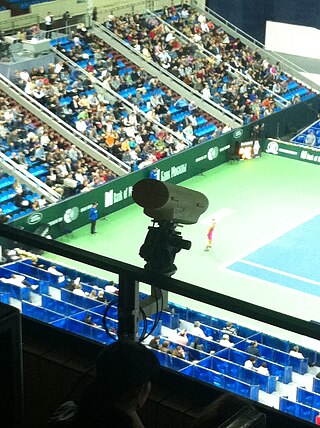
Hawk-Eye is a computer vision system used in numerous sports such as cricket, tennis, Gaelic football, badminton, hurling, rugby union, association football and volleyball, to visually track the trajectory of the ball and display a profile of its statistically most likely path as a moving image. The onscreen representation of the trajectory results is called Shot Spot.

The Game Boy Camera, released as Pocket Camera in Japan, is a Nintendo accessory for the handheld Game Boy game console. It was released on February 21, 1998, in Japan, and manufacturing ceased in late 2002. As a toy for user-generated content, it can be used to shoot grayscale photographs, edit them or create original drawings, and transfer images between GBC units or to the 64DD art game suite Mario Artist. The accessory featured a 180°-swivel front-facing camera that allowed users to capture selfies. Its images can be printed to thermal paper with the Game Boy Printer. The GBC's cartridge contains minigames based on Nintendo's early games such as the arcade video game Space Fever and the Game & Watch handheld game Ball, and a chiptune music sequencer; photographers have embraced its technological limitations as artistic challenges.

Super Mario 64 DS is a 2004 platform game developed and published by Nintendo for the Nintendo DS. It was a launch game for the DS. Super Mario 64 DS is a remake of the 1996 Nintendo 64 game Super Mario 64, with new graphics, characters, collectibles, a multiplayer mode, and several extra minigames. As with the original, the plot centers on rescuing Princess Peach from Bowser. Unlike the original, Yoshi is the first playable character, with Mario, Luigi, and Wario being unlockable characters in early phases of the game.

Sega Superstars is a party video game developed by Sonic Team for the PlayStation 2. It was published by Sega and released in Europe on October 22, 2004; in North America in November 2, 2004; and in Japan in November 11, 2004. The game features several minigames based on various Sega titles that are controlled using the EyeToy peripheral. Upon release, the game received "average" review scores from critics.

EyeToy: Play is a minigame compilation video game for the PlayStation 2, released in 2003. It was the first game to make use of the PlayStation 2's video camera accessory, EyeToy. The game was initially packaged with the EyeToy when the accessory was first released.

EyeToy: Groove is a dancing game developed by London Studio and published by Sony Computer Entertainment. It was released on November 14, 2003 in Europe, on April 20, 2004 in North America, and on June 24, 2004 in Japan as EyeToy: FuriFuri Dance Tengoku. In EyeToy: Groove the player must hit targets with their arms on the edges of the screen to the beat of the music.
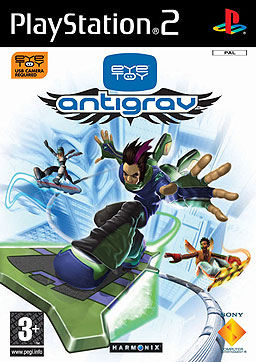
EyeToy: AntiGrav is a hoverboard game by Harmonix, released in November 2004 for the PlayStation 2. It was touted as the first "real" game for EyeToy targeted to more seasoned gamers. The earlier games such as Play and Groove were geared towards younger players for family or party fun. Unlike the earlier EyeToy games, the player's image is not shown inside the Antigrav game. Instead, the player's movement is reflected in the animated character in the game. The player moves their body to guide the on-screen character through a track. Some obstacles require the player to crouch or jump. Up to 4 players are supported. The game was released in the U.S. in November 2004, and in PAL in March 2005.
Instant replay or action replay is a video reproduction of something that recently occurred which was both shot and broadcast live.

Pac-Man Fever is a party game developed by Mass Media and published by Namco, released for GameCube and PlayStation 2 on September 3, 2002, exclusively released in North America. Players move about on a virtual game board, with the object of the game being to reach the end first. It allows for up to four players, featuring six characters from other Namco games to choose from: Pac-Man (Pac-Man), Astaroth (Soulcalibur), Heihachi Mishima (Tekken), Ms. Pac-Man (Pac-Man), Tiger Jackson (Tekken), and Reiko Nagase.
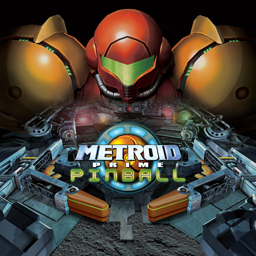
Metroid Prime Pinball is a pinball video game themed after the Metroid series. The game uses the graphical style and various story elements from Metroid Prime. It was developed by Fuse Games and published by Nintendo for the Nintendo DS in North America and Australia in 2005, in Japan in 2006, and in Europe in 2007. Metroid Prime Pinball uses the basic mechanics of pinball, along with typical pinball items. New mechanics are introduced, such as wall jumping and the ability to fire weapons. The Nintendo DS's touchscreen can be nudged with a finger to alter the pinball's trajectory while in motion.

EyeToy: Play 3 is the third game in the EyeToy: Play series, for up to four players. The camera takes snapshots during the game for your player and is a requirement to play the game. Unlike previous EyeToy: Play games, Play 3 was not released in North America. Unlike the previous games, 4 players were able to play on screen at the same time as opposed to taking it in turns like the previous games.

EyeToy: Monkey Mania, also known as Saru Eye Toy Ōsawagi! Wakki Waki Game Tenkomori!! in Asia, Japan, and Korea, is a party game based on the Ape Escape franchise that requires the EyeToy camera peripheral to play. The game consists of the franchise's titular monkeys engaging in minigames, with multiplayer for up to four players. The title was sold as a standalone game, and also in a bundle with a silver-colored EyeToy peripheral.
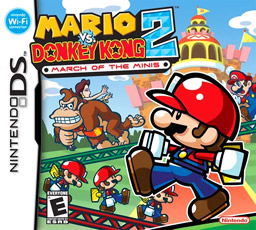
Mario vs. Donkey Kong 2: March of the Minis is a direct sequel to the Game Boy Advance game Mario vs. Donkey Kong released in 2006, which is a follow-up to the Game Boy Donkey Kong game, a partial remake of the original Donkey Kong with a greater focus on puzzle-solving. Gameplay involves the player controlling several Mini Marios with the touch screen, instead of Mario himself. The game also features the return of Pauline, last seen in the 1994 Donkey Kong. A sequel, called Mario vs. Donkey Kong: Minis March Again!, was released in June 2009.

Wii Play is a party video game developed and published by Nintendo for the Wii console. It was released as a launch game for the console in Japan, Europe, and Australia in December 2006, and was released in North America in February 2007. The game features nine minigames, including a Duck Hunt-esque shooting range, a fishing game, and a billiards game, each of which are designed to showcase the features of the Wii Remote controller.

Mario Super Sluggers is a sports and adventure video game for the Wii developed by Namco Bandai Games and Now Production, and published by Nintendo. It is part of the Mario Sports series, and the sequel to Mario Superstar Baseball for the GameCube. Mario Super Sluggers was released in Japan on June 19, 2008 and in North America on August 25, 2008. It was neither released in Europe nor Australia.
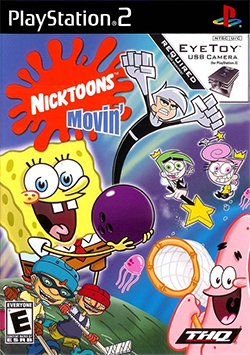
Nicktoons Movin' is a party video game developed by Mass Media and published by THQ released in 2004. It features characters from the shows SpongeBob SquarePants, Danny Phantom, Rocket Power, The Fairly OddParents, and The Adventures of Jimmy Neutron: Boy Genius. The game requires the EyeToy accessory to play.

The Playroom is a casual video game that is a collection of augmented reality mini-games. It was developed by Japan Studio's Team Asobi division, comes pre-loaded on all PlayStation 4 consoles, and is meant to demonstrate the use of the PlayStation Camera and the DualShock 4 controller. The PlayStation Camera accessory is required to play The Playroom. If a camera is not present, a trailer for The Playroom will be displayed instead of the full game. Firesprite, a studio founded by former employees of Studio Liverpool, worked on the visuals of The Playroom. Downloadable content is free.

Five Nights at Freddy's (FNaF) is a video game series and media franchise created by Scott Cawthon. The first video game was released on August 8, 2014, and the resultant series has since gained worldwide popularity.



















